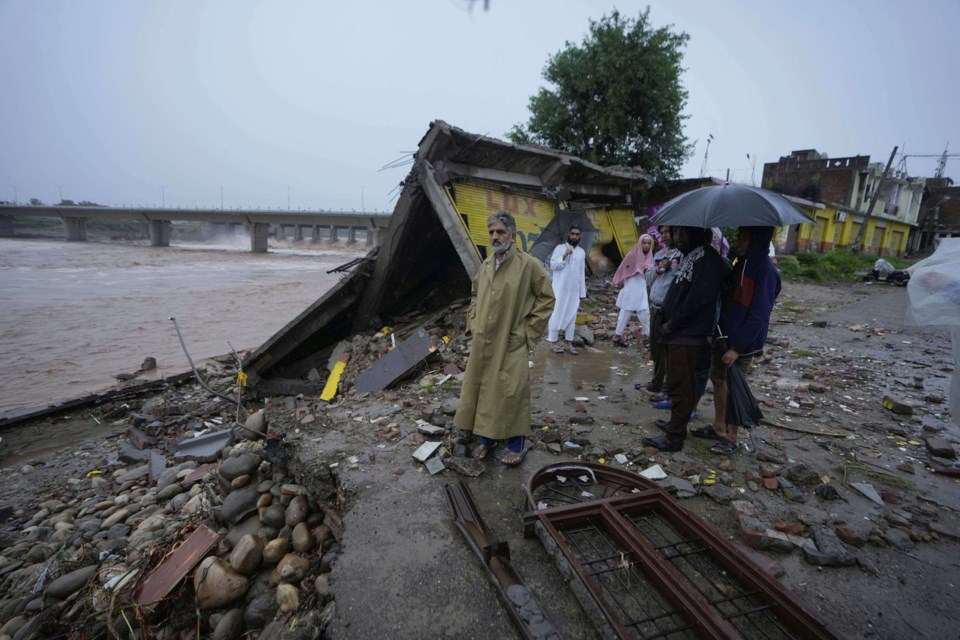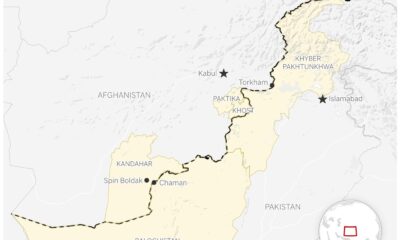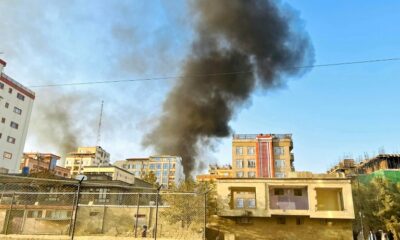Top Stories
Flash Floods Kill 34 in Kashmir, Displace 200,000 in Pakistan

URGENT UPDATE: Intense rains have triggered devastating flash floods in Indian-controlled Kashmir and Pakistan, resulting in at least 34 deaths and displacing over 200,000 people. The catastrophic weather events unfolded earlier today, with officials confirming that rescue operations are underway as the region braces for continued rainfall.
The floods have submerged significant areas, including the shrine of Guru Nanak, the founder of the Sikh religion, located in Narowal district near the Indian border. Rescue teams are racing against time to locate missing individuals, with reports indicating that over 150 people are unaccounted for in recent flood-related incidents.
In the Jammu region of Indian-controlled Kashmir, a mountainside collapse on a popular Hindu pilgrimage route has compounded the tragedy. Devotees en route to a revered hilltop temple were caught in the disaster, with most bodies recovered from the rubble. At least 18 others sustained injuries and were rushed to local hospitals, according to disaster management official Mohammed Irshad.
Rescue operations have been suspended temporarily for safety reasons as teams continue to search for survivors. Meanwhile, authorities in Pakistan’s eastern Punjab province have requested military assistance to aid in rescue and relief efforts. Lt. Gen. Inam Haider of the National Disaster Management Authority confirmed the dire situation, stating that army operations are critical to address the crisis.
The flooding has severely affected villages, particularly in Kasur, Okara, Bahawalnagar, and Sialkot districts, where rising waters from the Ravi, Chenab, and Sutlej rivers have inundated homes and infrastructure. Over 20,000 residents were evacuated overnight from the outskirts of Lahore, Pakistan’s second-largest city, as floodwaters posed an imminent threat.
As of now, floodwaters are rising dangerously, prompting mass evacuations across six districts. Irfan Ali Kathia, director-general of the Punjab Disaster Management Authority, highlighted that the situation is exacerbated by heavier-than-normal monsoon rains and water releases from overflowing dams in India.
In a concerning twist, India has communicated warnings of potential cross-border flooding through diplomatic channels, bypassing the Indus Waters Commission, a permanent mechanism established under the 1960 Indus Waters Treaty. This suspension has raised tensions, with Pakistan asserting that India cannot unilaterally dismiss treaty obligations.
The impact of these floods is staggering. Since late June, floods in Pakistan have killed over 800 people, with August alone accounting for nearly 100 fatalities due to similar weather patterns. The climate crisis is accelerating these disasters, with scientists indicating that climate change is fueling heavier monsoon rains in South Asia, raising fears of repeating the catastrophic 2022 floods that affected a third of Pakistan.
As the situation develops, authorities are urging residents in vulnerable areas to remain vigilant and heed evacuation notices. Rescue operations will continue in the coming days, with officials pushing for increased support and resources to mitigate the ongoing humanitarian crisis.
Stay tuned for further updates on this unfolding disaster as authorities continue to assess the full extent of the damage and provide assistance to affected communities.
-

 World3 months ago
World3 months agoScientists Unearth Ancient Antarctic Ice to Unlock Climate Secrets
-

 Entertainment3 months ago
Entertainment3 months agoTrump and McCormick to Announce $70 Billion Energy Investments
-

 Science3 months ago
Science3 months agoFour Astronauts Return to Earth After International Space Station Mission
-

 Lifestyle3 months ago
Lifestyle3 months agoTransLink Launches Food Truck Program to Boost Revenue in Vancouver
-

 Technology2 months ago
Technology2 months agoApple Notes Enhances Functionality with Markdown Support in macOS 26
-

 Top Stories1 week ago
Top Stories1 week agoUrgent Update: Fatal Crash on Highway 99 Claims Life of Pitt Meadows Man
-

 Sports3 months ago
Sports3 months agoSearch Underway for Missing Hunter Amid Hokkaido Bear Emergency
-

 Politics2 months ago
Politics2 months agoUkrainian Tennis Star Elina Svitolina Faces Death Threats Online
-

 Technology3 months ago
Technology3 months agoFrosthaven Launches Early Access on July 31, 2025
-

 Politics3 months ago
Politics3 months agoCarney Engages First Nations Leaders at Development Law Summit
-

 Entertainment3 months ago
Entertainment3 months agoCalgary Theatre Troupe Revives Magic at Winnipeg Fringe Festival
-

 Politics1 week ago
Politics1 week agoShutdown Reflects Democratic Struggles Amid Economic Concerns





















